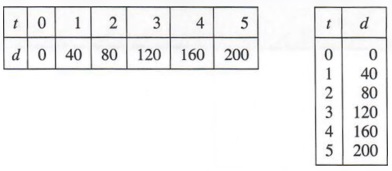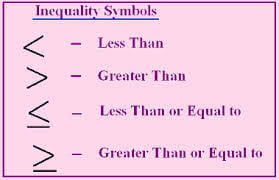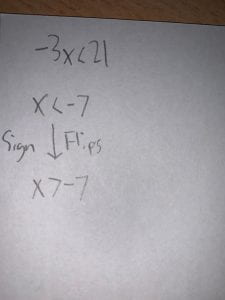Category: Grade 9
What I learned in Grade 9 Linear Relations
What is a Linear Relation
A linear relation is a pattern that increases or decreases by the same amount every time.
What is a T-Chart and How to fill it
When finding the rule for a linear relation, you can put the numbers in a t-chart. A t-chart helps you record your data in one table. This chart helps you find the relationship between x and y. On the left side of the chart is x, and the right is y.

How to find the Rule for a Pattern
The first step is to know how much the pattern changes each time. Once you know how much your pattern goes up/down by you put the number next to x. Next you insert 1 instead of x as it is the first number in the pattern. Example: 6(1)=y. You know that 6(1) does not equal 3. The next step is to find how you get from 6to 3. To get from 6 to 3 you subtract 3. Now add -3 to your rule. Your rule now looks like 6x-3=y. To see if this is correct, try it on the next number.

How to Plot a Point
On a graph, the horizontal line is the x axis and the vertical line is the y axis. The first number on your coordinates is the x number and the second number is the y. Example: 2,3 the 2 is x and 3 is y. The first number tells you which way you are going to go on the x axis. If the number is positive you go to the right and if the number is negative you go to the left. The second number tells you which way you are going on the y axis. If the number is positive you are going up the y axis and if the number is negative you are going down the y axis. If are coordinate is 2,3 you will go right 2 times, and then up 3 times. Once you have done this, you place your point where the coordinates lead.
How to Graph a Linear Relation
To graph a linear relation, put your equation into a t-chart. Once you have a couple pairs of numbers you can insert the points onto the graph. Example, the rule 6x-3=y, the first three numbers are 3,9,15. Now your t-chart has 1,2,3 in the x column, and 3,9,15 in the y column. When you put the two together you get your coordinates. For example, 1,3 2,69 3,15. Once you have these coordinates you can plot them on the graph.
How to Graph Vertical and Horizontal Lines
A vertical line goes across the x axis. This means that the formula you are going to use x = a number. For example x=3. A horizontal line goes across the y axis. This means that the formula you are going to use is y = a number. For example y=-3. This will create a horizontal line to the right and left of -23 on the y axis.
Vocabulary:
X Axis – The horizontal line on a graph.
Y Axis – The vertical line on a graph.
T-Chart – A chart that has two columns.
Quadrant – A graph that is split in 4 parts.
Origin- The middle of the graph.
Plotting – Where you place your point on a graph.
Linear Pattern – A pattern that increases or decreases by the same amount each time.
Increasing Pattern – A pattern that increases each time.
Decreasing Pattern – A pattern that decreases each time.
Horizontal Line – A line that runs from left to right.
Vertical Line – A line that runs top to bottom.
Something Else I learned
Something else that I learned in this unit is restricting your line to between two points. This is useful because without the formula, you will have a long line running from one side of the graph to the other.
Categories ‐ Self‐Assessment English 9
Found Poem
I made this by scrolling through emails I was sent by my teachers and chose some words that describe our current situation (being quarantined).
Good morning Gentlemen,
Taking care of yourself?
Let me know
Stay safe
Don’t worry
This time has been rough
Together we will get through this
I hope you are all well and safe
Avoid leaving your house
Until then please be patient
I’m here to help
This situation is new to everyone and we will get through it… together
Please stay safe.
Short Story – Graphic Novel
On the Sidewalk Bleeding News Article
 Loading...
Loading...
What I have learned About Grade 9 Inequalities
What is an Inequality
An inequality compares two values, showing if one is less than, greater than, or simply not equal to another value. Example: 2 > 1.
What the symbols mean
An inequality has 1 out of 4 different signs. The first sign is >, which is the greater than sign. This sign is used when the number on the left is bigger than the on the right. The second sign is <, which is the less than sign. A less than sign is used when the number on the left is smaller than the number on the right. The third sign is ≥, which is the greater than or equal to sign. This sign is used when the number on the left can be greater or equal to the number on the right. The fourth sign is ≤, which is the less than or equal to sign. This sign is placed when the number on the left is less than or equal to the number on the right. Examples: 3 > 2, 7 < 8, x ≥ 13, 9 ≤ x.
How to solve
Solving inequalities is almost exactly like solving an equation; legal moves. The only difference is when you are dividing by a negative, you need to flip the sign. Example, if you have -3x < 21, after you divide and get x < -7 you need to flip the sign, so your answer becomes x > -7
How to graph an inequality
To graph an inequality on a number line, you need to know how to identify what the sign is. If the sign is < or > than you will put an open dot on your graph and if the sign is ≤, or ≥, you will place a closed dot on your graph. Once you know what kind of dot you need, you need to find the number that is the inequality with x. For example x > 10. You would find 10 on your number line. Once you have found 4 draw the dot on top of the 4. The direction your arrow goes depends on the sign. For our example, x > 4 the arrow would go to the right of 4. This is saying that x can be any number to the right of 4.
How to check an inequality
Since solving inequalities are very similar to solving equations, checking is also mainly the same. To check your solution, you replace the variable with your answer. Example: 2x+4 > 8. When you do all your legal moves you end up with x > 2. From here, your answer should be 2. Now you replace the variable with 2 and solve. 2(2) + 4 > 8 turns into 4 + 4 > 8, then 8 > 8.Now you know that your number is right. There is also a second to check and inequality. The second way to check is to make sure the sign is going the right way. To do this you need to put any number that is greater than 2 into the question. Example: 2(10) + 4 > 8 turns into 24 > 8 which is a correct statement.
Sea Devil
Why does the man fish by night? How does this lead to the conflict with the ray? What is significant about the fact that he does not fish for a living?
The man liked to fish at night because he liked to fish alone. This leads to the conflict because he is unable to see what he is catching when it’s dark and night. The man fishes as a hobby, not for a job.
Identify 3 examples of foreshadowing?
When the man slipped the knot over his wrists.
When the man said he let the baby porpoise go.
When it says “he looked closely to make sure no stingray was hidden in the mesh.”
Identify the following parts of the story’s plot: The complicating incident, a single crisis, the climax, the resolution and the ending (what kind)?
The complicating incident: The man wasn’t going to cast anything until he saw two or three mullets together.
A single crisis: When the man realized that he had caught a sea devil instead of some mullets.
The climax: When the ray swam quickly and he decided to cut the rope, as his plan worked out in the end.
The resolution: The man decided to let the mullet go and he would never go casting at night alone.
The ending: The ending is happy because he was saved and realized that its harder then he thought.
One of the conflicts is between the civilized and primitive world (define these two words first). What is the purpose of the references made to the plane, the causeway, and the mans wife at home?
Civilized world is where everyone is living and everything’s modern and developed.
Primitive world is where objects are only the natural aspects of earth and nature.
What does the man learn at the end of the story? Why does he release the mullet?
At the end of the story, the man learnt how it feels to not be the fisher/hunter and how to be the man that is trapped. The man had decided to release the mullet because the ray kind of taught the man a lesson of how it felt to be caught up, as the man felt sorry for the mullet.
Find 3 examples of descriptive language – this will lead into a discussion of figurative language.
Personification – “the good, rough, honest wood”
simile – “a great horned thing shot like a huge bat of of the water”
figurative language – “ he saw the mullet he had just caught, gasping its life away on the floor boards of the skiff.”
Vocabulary:
- sullen p.32: bad-tempered and sulky; gloomy.
- weltering p.33: to rise and fall or toss about in or with waves
- elemental p.33: having the power of a force of nature
- sinewy p.33: tough and difficult to cut, stringy
- hoisted p.33: to raise something by using ropes or strength
- phosphorescence p.34: luminescence that is caused by the absorption of radiations
- cordage p.34: the ropes in the rigging of a ship or boat
- exhilaration p.34: feeling of great happiness and excitement
- atavistic p. 35: a recurrence to a past style, manner, outlook, or activity
- centrifugal p. 35: moving away from a center
- gauntly p. 35: barren, desolate
- impeding p. 37: to slow the movement, progress, or action of something
- tenaciously p.37: very determined to do something
- respite p. 38: a period of temporary delay
- equilibrium p. 38: a state of balance, one force is not stronger than the other
- imminent p. 39: happing really soon
A Mountain Journey – Questions & Vocabulary
Questions:
1. What was Dave Conroy doing out in the wilderness? (motivation)
Dave Conroy was capturing animals for their fur in the wilderness.
2. At what point does the reader know the protagonist is in serious trouble and not likely to make it to MacMoran’s cabin? (plot)
The point where you know Conroy is in trouble is when you know he can’t make it to the cabin.
3 . What three critical mistakes did Conroy make? What are some of the things he could have done to prevent himself from freezing? (plot)
One mistake that Conroy made was having too much confidence of his ability to make it to the cabin after not stopping when he fell in the river and not realizing that he had hypothermia. If he hadn’t he could have rested and not keep walking to the cabin. Also, if he had stopped after he had fallen into the river, he still would be fine. Him not realizing that he had hypothermia was his biggest mistake because that is how he died. If he had realized this sooner, he could have made a fire before his hands became numb.
4. Determine the elements of plot in this story: exposition, complicating incident, 3 crises, climax, and the denouement.
Exposition: Conroy is outside in the wilderness and the only thing stopping him and what was in his way.
3 Crisises:
1. Conroy fell into a small river.
2. Conroy got to the cabin and saw that it was all gone.
3. Conroy tried to make a fire, but he couldn’t because his hands were too cold.
Climax: He gets to his cabin once its all gone so he decides to hike to another cabin to spend the night. While he was on the way he got tired and lied down to take a rest then he fell asleep.
5. Describe the setting – how does the setting affect the plot and the theme of the story? What is the theme – write a theme statement for this story.
The setting is in Hoodoo creek, Alberta, in the winter. The setting affects the plot by being the antagonist in the story. It also effects the theme by making Conroy try to be tough out the wilderness.
6. Find one example of symbolic setting (concrete place that represents something abstract) and explain its meaning.
The tree that was calling Conroy’s name was a symbolic setting because that is not a normal occurrence and it was a message to stop going.
7. Quote four images from the story that make effective comparisons (figurative language: simile, metaphor, and personification)
Simile: “At every step too, he had broken tail and his skis had sunk a foot in the new snow, white and soft as flour. ”
Simile: “That tree, like a strong and lonely woman, called to his weary body to stop.”
Personification: “The wind was rising with the sundown. It whipped snow against his face, cut through the weave of his 2 woolen mitts, set the forest moaning beside him.”
Metaphor: “The cold was an old man’s fingers feeling craftily through his clothes.”
Vocabulary:
1. eternal p.92: lasting or existing forever; without end or beginning
2. immobility p.93: the state of not moving; motionlessness
3. opaque p.93: not able to be seen through; not transparent
4. reverberation p.93: prolongation of a sound; resonance
5. momentum p.93: the quantity of motion of a moving body
6. cadaverous p.94: resembling a corpse in being very pale, thin, or bony.
7. congregated p.95: gather into a crowd or mass.
8. inundation p.95: an overwhelming abundance of people or things.
9. beggared p.95: reduce (someone) to poverty.
10. filched. P.96: pilfer or steal (something, especially a thing of small value) in a casual way.
Feminism
https://www.un.org/en/sections/issues-depth/gender-equality/
Who does it involve?
This article involves the UN’s women’s situation on inequality. The article talks about a declaration that talks about how humans should be equally treated despite gender, race, and others. Even though this declaration was written in 1948, this still should be true today. This article also talks about the Beijing Conference on Woman in 1995, which was a large step for feminism. In the article, though woman want equality and more rights, they do not specify how they are going to achieve this goal of theirs which still leaves a question unanswered.
Why did you choose this article?
I chose this article because it has the opinions of women’s perspective on inequality and it informs me on their situation. This article also was one of the top articles when I searched up “gender equality issues” so this article is very popular and hopefully accurate.
How does this news article relate to the story we are reading- The Friday Everything Changed?
This subject is almost the same as The Friday Everything Changed, equal rights. In the book, the girls in the class wanted equality, and this is a problem for women in the real world. Women want to be equal or more than men, just like the book.













